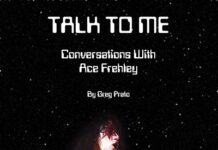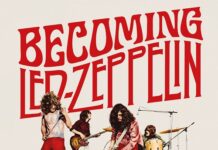By Ira Kantor
It goes without question that the ongoing coronavirus pandemic is turning lives upside down, with seemingly no end in sight. We strive daily to maintain some semblance of routine and normalcy for ourselves and our loved ones though it’s not easy. For my wife Jen and I, our days are now spent hunched over laptops at a dining room table, all while taking turns to keep our 2-year-old Freddie happy and active.
While we can consider ourselves lucky to be safe, healthy and together during this time, it doesn’t detract from the undeniable sadness surrounding the fact there are thousands upon thousands of people worldwide currently suffering as a result of coronavirus.
In tandem with my family, I seek comfort in times of unfamiliarity and heavy-heartedness from a companion I’ve loved for 25 years — music. It’s cliché, but I’m fully convinced music has the power to restore, heal, and provide peace. What helps get me through each day as I try to stay optimistic about the future is putting my Bose headphones on and pressing a play button. As I work; as I function; as I attain emotional solace, I rely on music to keep me happy and energized, especially new artists and albums that fall outside my scope of existing knowledge.
Recently, an employee at the company I work for posed a simple question across a web forum. I soon realized it was a question designed to help us build connections and solidarity as we fight to stay sane during this pandemic.
The question was as follows: “What are y’all listening to right now?”
Answers varied across employees. Some chose different genres. Some different bands. Some different albums. In my case, I immediately offered a few examples from one of my many playlists — Bob Welch’s “Sentimental Lady,” Ultravox’s “Dancing with Tears in My Eyes,” “Chase” by Giorgio Moroder, “Breath” by Pere Ubu.
While I know I need to immerse myself in such platforms as Spotify and Apple Music, YouTube has always been my go-to for uncovering “new music.” It’s the template I use to listen to albums in full before buying them. This is the site that introduced me to the eerie accessibility of bands like Aphrodite’s Child (666), Goblin (any of their soundtrack work), and Hawkwind (Hall of the Mountain Grill). It’s my standard reference tool when working to assemble my Vinyl Confessions columns.
In thinking further about the question posed above, I’ve ultimately decided that in this period of uncertainty, I want to get out of my comfortable world of musical familiarity as well. If it’s one thing I love, it’s bands or albums best classified as under-the-radar. The following examples I’m about to share with you (discovered over the past few days) have this element in spades. That’s why they make for the best kind of distraction as of late:
Dominique Guiot — L’Univers De La Mer
Combining tranquil guitar melodies with prog-worthy keyboard melodies, this concept album could have easily been an offshoot of Mike Oldfield’s post Tubular Bells efforts, including Hergest Ridge (1974) and Ommadawn (1975). Using the sea as its primary motif, this all-instrumental album works its way through different moods and modern and medieval sounds, adding to its overall mystery. Broken up into 12 mini movements, this album could have elevated the French composer to the pantheon of say a Jean Michel Jarre. However, the fact there is no Wikipedia page for either Guiot or the album makes it even more mysterious and unique. The cover alone prompted me to click the play button in this case. One comment listed below the album on YouTube sums it up best: “God damn, that art looks exactly how this sounds.” I concur.
Jun Fukamachi — Quark
If you merged Joe Zawinul, Keith Emerson and Stomu Yamashta together, you would produce Jun Fukamachi – a Japanese jazz fusion veteran (the Brecker Brothers) who did for the synthesizer what Yamastha did for jazz-influenced percussion in the 1970s. The power chords and romp of the title track alone make this a worthwhile listen. “Perpetual (Movement)” could easily double as an Alan Parsons Project outtake. Sadly, Fukamachi passed away a decade ago but this album, which turns 40 this year, is a fascinating introduction into his talents. It features one instrument shaped and molded in glorious ways. Even the minimalist “Insight” builds up great suspense as listeners await Fukamachi’s seemingly improvised musical intentions. How he was never a member of the fusion band Hiroshima amazes me. For a further listen of his virtuosity, give a listen to snippets from his piano/synth album ode to Sgt. Pepper’s Lonely Hearts Club Band. I know few artists who can rework musical flourishes to the orchestral genius of “A Day In The Life” and make it sound entirely like their own composition.
Tropea — Short Trip to Space
I’m not going to lie — I took one look at this album cover and assumed it would be a terrific work of progressive beauty, as complemented by the iconic artistry of Roger Dean. I was wrong. It’s neither Dean’s artwork nor is it a prog album. Rather it’s jazz fusion with a hearty dose of funk added in. My fault, I should have guessed that from the very first track, entitled — no joke — “The Funk You See, Is The Funk You Do.” This album is an ear-pleasing crock pot of soulful, hook-laden goodness. One listen and I hear Tower of Power, “Rise”-era Herb Alpert, Earth, Wind & Fire, War, the Average White Band, Sly and the Family Stone, Parliament-Funkadelic, the Crusaders, and many other influences. If Steely Dan didn’t listen to most of this album when conjuring up Gaucho — including the album’s title track and “Blue Too” — then they missed something spectacular. Though leader John Tropea would earn his name and reputation playing guitar alongside such icons as Harry Chapin, Laura Nyro and Paul Simon, this — his band’s second album — should have put him on the map to stardom, never mind other unworldly musical dimensions.
Eloy — Ocean
This German prog powerhouse named themselves after a futuristic human race from H.G. Wells’ classic work “The Time Machine.” It makes sense as their music sounds not of this earth.
Though Ocean marks the band’s sixth studio attempt at success, it’s a stunning four-movement effort, one that turns the near-fairytale mythological elements of Poseidon and Atlantis into the best follow up to Nektar’s “A Tab in the Ocean” I’ve ever heard. Nearly five minutes of instrumental workouts occur even before group leader Frank Bornemann begins his stream-of-consciousness storytelling in track one. You can’t listen to this album and not conjure up every prog peer in the bunch. Literally, work your way down the alphabet from A (Aphrodite’s Child) to at least as far as Y (Yes) as you listen. For any fans of the prog rock genre, please take my advice and get hold of this album as quickly as you can. Fortunately, YouTube has most of their albums in full to check out. I’d also recommended Inside (1973) and Dawn (1976) as they are worthy contenders as well.
Jeff Wayne — Jeff Wayne’s Musical Version of The War of the Worlds
All that’s seemingly missing from this behemoth of a masterwork is Rick Wakeman. How did this concept escape his clutches during his solo heyday?
This album is apocalyptic, intense, and undeniably entrancing. Even the processed martian cries of “Ulla!” throughout have groove to them. Jeff Wayne’s interpretation of the H.G. Wells classic (there’s Wells again!) is equal parts Andrew Lloyd Webber grandiosity and prog rock majesty. Think the Alan Parsons Project’s Tales of Mystery and Imagination multiplied to the nth degree. Richard Burton narrates while the Moody Blues’ Justin Hayward bares his musical soul. Even Irish rock legend Phil Lynott gets in on the action with the epic “The Spirit of Man.” Talk about enduring in unfamiliar times; this album not only takes the cake, it wolfs it down with relish.
Cerrone — Supernature (Cerrone 3)
Vying neck and neck with disco producer king Giorgio Moroder for danceable supremacy, this French maestro gives us “The Island of Dr. Moreau” (do Wells’ kin get royalties from these artists?) with a heavy blast of glitter and roller skates added into the mixture. If you can put aside the album’s abomination of a cover, you actually get a catchy work that could be the global counterpart to Grace Jones’ Tom Moulton-produced albums (especially Fame). The surprisingly dynamic vocal stylings of Lene Lovich also add a nice amount of accessibility to the work overall. One listen to the title track and you’ll wonder just how much inspiration Moroder took from it to write “Chase.”
*
May you all stay safe, stay strong, and keep listening. Together, we will get through this!




















